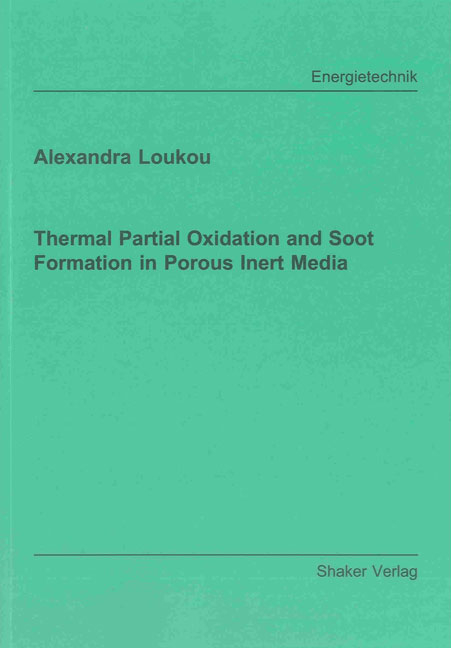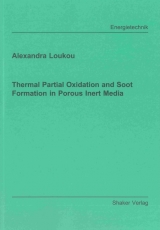Thermal Partial Oxidation and Soot Formation in Porous Inert Media
Seiten
- Keine Verlagsinformationen verfügbar
- Artikel merken
This thesis investigates the production of syngas from rich methane / air mixtures. The examined process is based on partial oxidation that was experimentally carried out without the use of catalysts. In order to overcome technical difficulties arising from catalyst exclusion, the process was studied using porous media based reactors. The employed porous media are inert ceramic materials, which promote internal heat recirculation within the reaction zone and consequently, superadiabatic combustion. Unlike other porous media based reformers, an important feature of the examined reactor is the ability to operate on the basis of stationary flames. For testing purposes, different reactor prototypes were constructed using different types of porous media, namely 10 ppi SiSiC reticulated foams and packing material (Raschig rings) out of high alumina (> 97% Al2O3). The analysis of the experimental results was supported by numerical simulations with a quasi-1D model, which takes into account the gasand solid-phase energy balances, convective heat transfer between gas and solid phases, solidphase radiation, and detailed chemistry for combustion.
The obtained experimental results demonstrate that the reactor is capable of stationary operation with preheated rich methane / air mixtures, for a wide range of thermal loads and equivalence ratios. This is a significant advantage with regard to its practical application, which is pertinent to the field of fuel cells, and particularly to SOFC based micro-CHP systems. The highest reforming efficiencies were recorded in the case of the SiSiC foam based prototypes, which reached 70% taking into account both H2 and CO streams in the syngas. The efficiency of the Al2O3 packed bed prototype was lower (62%) but the application of this material was found to be very advantageous as far as reactor robustness is concerned. Peak temperatures measured within the porous zone provide evidence of superadiabatic combustion for both types of porous media. Superadiabatic combustion is also confirmed by the numerically predicted temperature profiles with the quasi-1D model.
Using the SMPS technique, characteristics of generated soot particles were mapped for ranges of sets of operating conditions. These characteristics include size and concentrations of particles within the syngas. This part of the experimental study holds particular importance, taking into account the scarcity of similar data from experiments with porous media based reformers. The results showed that in regimes of efficient reactor operation, soot is present in the form of nanoparticles. For same operating conditions, it was found that the SiSiC foam reactor produces particles that are at least 5 nm smaller compared to those detected within the samples from the Al2O3 packed bed reactor. It was also found that the soot limit of the process lies at a higher equivalence ratio in the case of the SiSiC foam reactor.
The obtained experimental results demonstrate that the reactor is capable of stationary operation with preheated rich methane / air mixtures, for a wide range of thermal loads and equivalence ratios. This is a significant advantage with regard to its practical application, which is pertinent to the field of fuel cells, and particularly to SOFC based micro-CHP systems. The highest reforming efficiencies were recorded in the case of the SiSiC foam based prototypes, which reached 70% taking into account both H2 and CO streams in the syngas. The efficiency of the Al2O3 packed bed prototype was lower (62%) but the application of this material was found to be very advantageous as far as reactor robustness is concerned. Peak temperatures measured within the porous zone provide evidence of superadiabatic combustion for both types of porous media. Superadiabatic combustion is also confirmed by the numerically predicted temperature profiles with the quasi-1D model.
Using the SMPS technique, characteristics of generated soot particles were mapped for ranges of sets of operating conditions. These characteristics include size and concentrations of particles within the syngas. This part of the experimental study holds particular importance, taking into account the scarcity of similar data from experiments with porous media based reformers. The results showed that in regimes of efficient reactor operation, soot is present in the form of nanoparticles. For same operating conditions, it was found that the SiSiC foam reactor produces particles that are at least 5 nm smaller compared to those detected within the samples from the Al2O3 packed bed reactor. It was also found that the soot limit of the process lies at a higher equivalence ratio in the case of the SiSiC foam reactor.
| Erscheint lt. Verlag | 28.3.2014 |
|---|---|
| Reihe/Serie | Berichte aus der Energietechnik |
| Sprache | englisch |
| Maße | 148 x 210 mm |
| Gewicht | 281 g |
| Einbandart | Paperback |
| Themenwelt | Technik ► Elektrotechnik / Energietechnik |
| Schlagworte | Energietechnik • Thermal Partial Oxidation • Wärmetechnik |
| ISBN-10 | 3-8440-2698-3 / 3844026983 |
| ISBN-13 | 978-3-8440-2698-6 / 9783844026986 |
| Zustand | Neuware |
| Haben Sie eine Frage zum Produkt? |
Mehr entdecken
aus dem Bereich
aus dem Bereich
DIN-Normen und Technische Regeln für die Elektroinstallation
Buch | Softcover (2023)
Beuth (Verlag)
86,00 €
Kolbenmaschinen - Strömungsmaschinen - Kraftwerke
Buch | Hardcover (2023)
Hanser (Verlag)
49,99 €




